当代语言学导论复习要点(详细!含课后单词)
- 格式:doc
- 大小:349.50 KB
- 文档页数:31
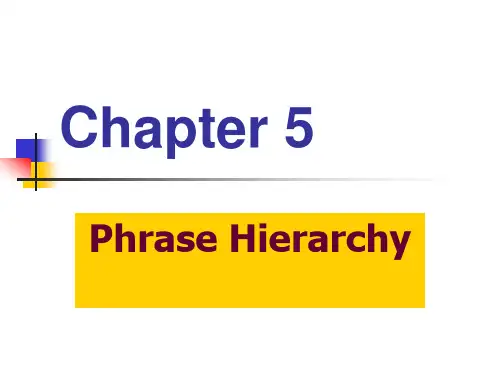
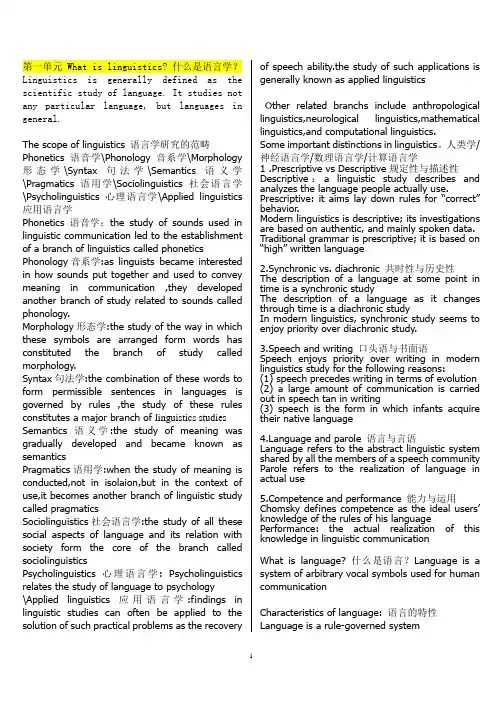
第一单元What is linguistics? 什么是语言学?Linguistics is generally defined as the scientific study of language. It studies not any particular language, but languages in general.The scope of linguistics 语言学研究的范畴Phonetics语音学\Phonology音系学\Morphology 形态学\Syntax句法学\Semantics语义学\Pragmatics语用学\Sociolinguistics社会语言学\Psycholinguistics心理语言学\Applied linguistics 应用语言学Phonetics语音学:the study of sounds used in linguistic communication led to the establishment of a branch of linguistics called phonetics Phonology音系学:as linguists became interested in how sounds put together and used to convey meaning in communication ,they developed another branch of study related to sounds called phonology.Morphology形态学:the study of the way in which these symbols are arranged form words has constituted the branch of study called morphology.Syntax句法学:the combination of these words to form permissible sentences in languages is governed by rules ,the study of these rules constitutes a major branch of linguistics studies Semantics语义学:the study of meaning was gradually developed and became known as semanticsPragmatics语用学:when the study of meaning is conducted,not in isolaion,but in the context of use,it becomes another branch of linguistic study called pragmaticsSociolinguistics社会语言学:the study of all these social aspects of language and its relation with society form the core of the branch called sociolinguisticsPsycholinguistics心理语言学: Psycholinguistics relates the study of language to psychology\Applied linguistics应用语言学:findings in linguistic studies can often be applied to the solution of such practical problems as the recovery of speech ability.the study of such applications is generally known as applied linguisticsOther related branchs include anthropological linguistics,neurological linguistics,mathematical linguistics,and computational linguistics.Some important distinctions in linguistics。
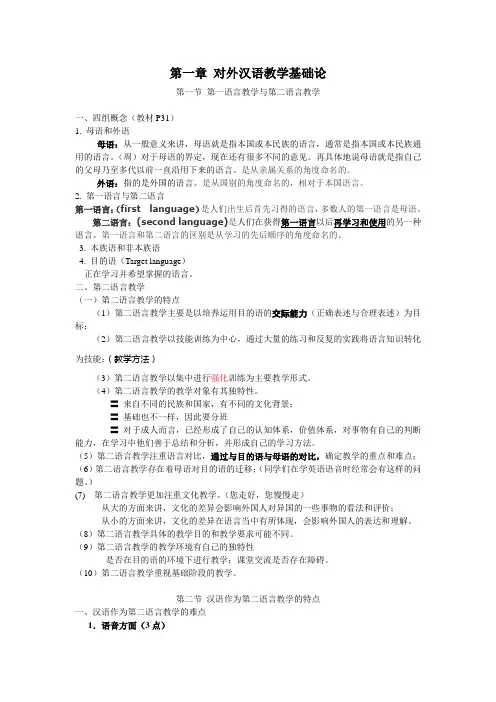
第一章对外汉语教学基础论第一节第一语言教学与第二语言教学一、四组概念(教材P31)1. 母语和外语母语:从一般意义来讲,母语就是指本国或本民族的语言,通常是指本国或本民族通用的语言。
(周)对于母语的界定,现在还有很多不同的意见。
再具体地说母语就是指自己的父母乃至多代以前一直沿用下来的语言。
是从亲属关系的角度命名的。
外语:指的是外国的语言。
是从国别的角度命名的,相对于本国语言。
2. 第一语言与第二语言第一语言:(first language)是人们出生后首先习得的语言,多数人的第一语言是母语。
第二语言:(second language)是人们在获得第一语言以后再学习和使用的另一种语言。
第一语言和第二语言的区别是从学习的先后顺序的角度命名的。
3. 本族语和非本族语4. 目的语(Target language)正在学习并希望掌握的语言。
二、第二语言教学(一)第二语言教学的特点(1)第二语言教学主要是以培养运用目的语的交际能力(正确表述与合理表述)为目标;(2)第二语言教学以技能训练为中心,通过大量的练习和反复的实践将语言知识转化为技能;(教学方法)(3)第二语言教学以集中进行强化训练为主要教学形式。
(4)第二语言教学的教学对象有其独特性。
〓来自不同的民族和国家,有不同的文化背景;〓基础也不一样,因此要分班〓对于成人而言,已经形成了自己的认知体系,价值体系,对事物有自己的判断能力,在学习中他们善于总结和分析,并形成自己的学习方法。
(5)第二语言教学注重语言对比,通过与目的语与母语的对比,确定教学的重点和难点;(6)第二语言教学存在着母语对目的语的迁移;(同学们在学英语语音时经常会有这样的问题。
)(7)第二语言教学更加注重文化教学。
(您走好,您慢慢走)从大的方面来讲,文化的差异会影响外国人对异国的一些事物的看法和评价;从小的方面来讲,文化的差异在语言当中有所体现,会影响外国人的表达和理解。
(8)第二语言教学具体的教学目的和教学要求可能不同。
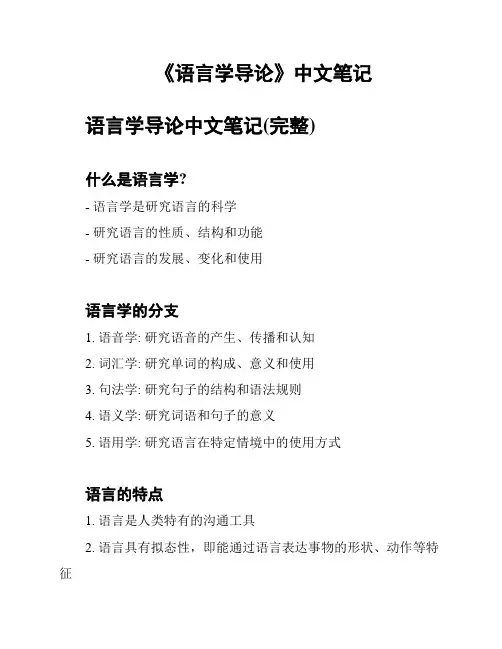
《语言学导论》中文笔记语言学导论中文笔记(完整)什么是语言学?- 语言学是研究语言的科学- 研究语言的性质、结构和功能- 研究语言的发展、变化和使用语言学的分支1. 语音学: 研究语音的产生、传播和认知2. 词汇学: 研究单词的构成、意义和使用3. 句法学: 研究句子的结构和语法规则4. 语义学: 研究词语和句子的意义5. 语用学: 研究语言在特定情境中的使用方式语言的特点1. 语言是人类特有的沟通工具2. 语言具有拟态性,即能通过语言表达事物的形状、动作等特征3. 语言具有符号性,即语言中的单词和语法符号代表着特定的意义4. 语言是可以研究和教授的,通过语言能够传递文化和知识语言的功能1. 意指功能: 通过语言表达思想、情感和意图2. 表示功能: 通过语言描述和描绘事物、现象和过程3. 交际功能: 通过语言实现沟通和交流4. 记忆功能: 通过语言记录和传递信息5. 心理功能: 通过语言影响和塑造个体的心理活动语言与文化- 语言是文化的一部分,反映了社会和文化的价值观和观念- 不同的语言体现了不同的文化方式和思维方式- 语言的变化和发展与文化的变迁和演变相互关联语言的变化和发展- 语言是动态的,不断发展和变化- 语言变化的原因包括:社会文化变迁、语言接触和语言演化- 语言变化常常由语言使用者的创新和共同接受推动语言的使用- 语言使用涉及语言使用者的语法知识、语境理解和交际目的- 语言的使用方式受到社会、文化、地域等因素的影响- 语言的使用也受到个体因素和语言使用者之间的关系影响以上是《语言学导论》的简要笔记,介绍了语言学的定义、分支、特点、功能、与文化关系、变化和使用等方面的内容。
对于进一步学习语言学的人来说,这份笔记能够提供一个全面的概览,并为深入研究打下基础。
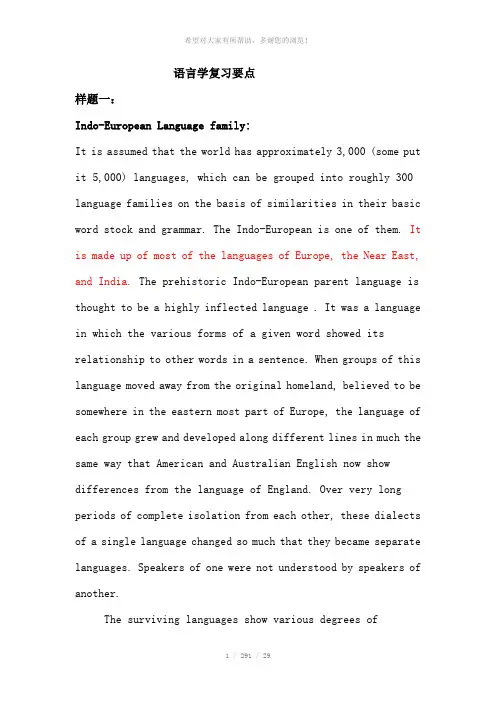
语言学复习要点样题一:Indo-European Language family:It is assumed that the world has approximately 3,000 (some put it 5,000) languages, which can be grouped into roughly 300 language families on the basis of similarities in their basic word stock and grammar. The Indo-European is one of them. It is made up of most of the languages of Europe, the Near East, and India. The prehistoric Indo-European parent language is thought to be a highly inflected language . It was a language in which the various forms of a given word showed its relationship to other words in a sentence. When groups of this language moved away from the original homeland, believed to be somewhere in the eastern most part of Europe, the language of each group grew and developed along different lines in much the same way that American and Australian English now show differences from the language of England. Over very long periods of complete isolation from each other, these dialects of a single language changed so much that they became separate languages. Speakers of one were not understood by speakers of another.The surviving languages show various degrees ofsimilarity to one another. The similarity bear a more or less direct relationship to their geographical distribution.They accordingly fall into eight principal groups, which can be grouped into an Eastern set: Balto-Slavic , Indo-Iranian, Armenian and Albanian; a Western set: Celtic, Italic, Hellenic, Germanic.In the Eastern set, Armenian and Albanian are each the only modern language respectively. The Balto-Slavic comprises such modern languages as Prussian, Lithuanian, Polish, Czech, Bulgarian, Slovenian and Russian. In the Indo-Iranian we have Persian, Bengali, Hindi, Romany , the last three of which are derived from the dead language Sanskrit.In the Western set, Greek is the modern language derived from Hellenic. In the Celtic, we find Scottish, Irish, Welsh, Breton, etc. The five Romance languages, namely, Portuguese, Spanish, French, Italian, Roumanian all belong to the Italic through an intermediate language Latin. The Germanic family consists of the four Northern European Languages, which are generally known as Scandinavian languages. Then there is German, Dutch, Flemish and English.All these languages have some influence on English to a greater or lesser extent because each has lent words into the English vocabulary. Some of them have played a considerable role in the course of the development of the English vocabulary.Sense relations between words:Synonymy: the sameness or close similarity of meaning. 同义现象是指意义的相同或极为相近。
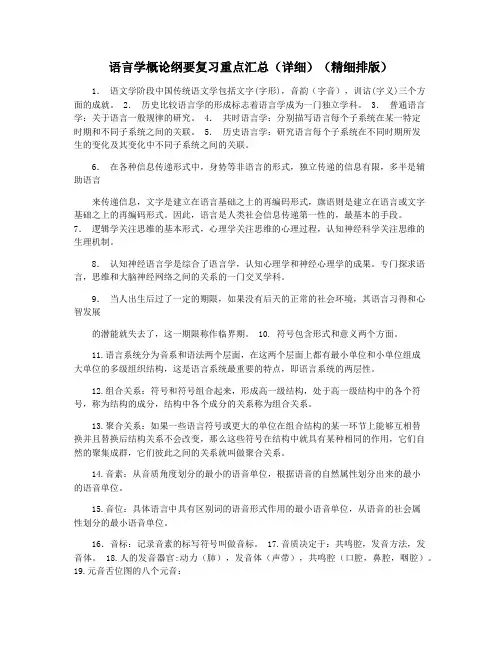
语言学概论纲要复习重点汇总(详细)(精细排版)1.语文学阶段中国传统语文学包括文字(字形),音韵(字音),训诂(字义)三个方面的成就。
2.历史比较语言学的形成标志着语言学成为一门独立学科。
3.普通语言学:关于语言一般规律的研究。
4.共时语言学:分别描写语言每个子系统在某一特定时期和不同子系统之间的关联。
5.历史语言学:研究语言每个子系统在不同时期所发生的变化及其变化中不同子系统之间的关联。
6.在各种信息传递形式中,身势等非语言的形式,独立传递的信息有限,多半是辅助语言来传递信息,文字是建立在语言基础之上的再编码形式,旗语则是建立在语言或文字基础之上的再编码形式。
因此,语言是人类社会信息传递第一性的,最基本的手段。
7.逻辑学关注思维的基本形式,心理学关注思维的心理过程,认知神经科学关注思维的生理机制。
8.认知神经语言学是综合了语言学,认知心理学和神经心理学的成果。
专门探求语言,思维和大脑神经网络之间的关系的一门交叉学科。
9.当人出生后过了一定的期限,如果没有后天的正常的社会环境,其语言习得和心智发展的潜能就失去了,这一期限称作临界期。
10. 符号包含形式和意义两个方面。
11.语言系统分为音系和语法两个层面,在这两个层面上都有最小单位和小单位组成大单位的多级组织结构,这是语言系统最重要的特点,即语言系统的两层性。
12.组合关系:符号和符号组合起来,形成高一级结构,处于高一级结构中的各个符号,称为结构的成分,结构中各个成分的关系称为组合关系。
13.聚合关系:如果一些语言符号或更大的单位在组合结构的某一环节上能够互相替换并且替换后结构关系不会改变,那么这些符号在结构中就具有某种相同的作用,它们自然的聚集成群,它们彼此之间的关系就叫做聚合关系。
14.音素:从音质角度划分的最小的语音单位,根据语音的自然属性划分出来的最小的语音单位。
15.音位:具体语言中具有区别词的语音形式作用的最小语音单位,从语音的社会属性划分的最小语音单位。
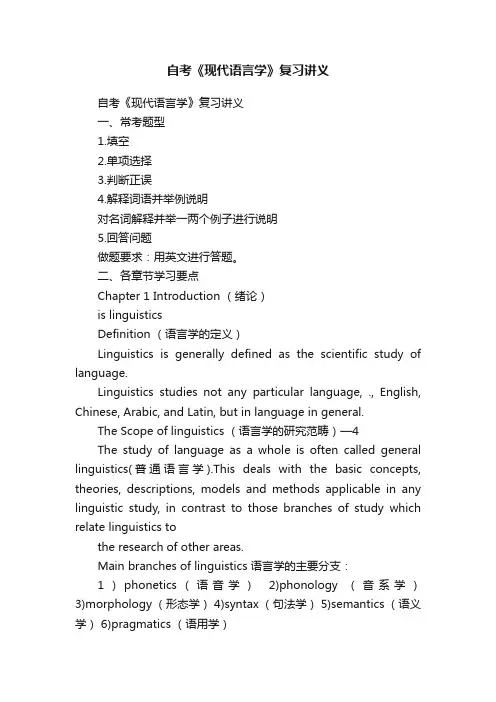
自考《现代语言学》复习讲义自考《现代语言学》复习讲义一、常考题型1.填空2.单项选择3.判断正误4.解释词语并举例说明对名词解释并举一两个例子进行说明5.回答问题做题要求:用英文进行答题。
二、各章节学习要点Chapter 1 Introduction (绪论)is linguisticsDefinition (语言学的定义)Linguistics is generally defined as the scientific study of language.Linguistics studies not any particular language, ., English, Chinese, Arabic, and Latin, but in language in general.The Scope of linguistics (语言学的研究范畴)—4The study of language as a whole is often called general linguistics(普通语言学).This deals with the basic concepts, theories, descriptions, models and methods applicable in any linguistic study, in contrast to those branches of study which relate linguistics tothe research of other areas.Main branches of linguistics 语言学的主要分支:1)phonetics(语音学)2)phonology (音系学)3)morphology (形态学) 4)syntax (句法学) 5)semantics (语义学) 6)pragmatics (语用学)The study of all these aspects of language forms the core of linguistics.Findings in linguistic studies can often be applie3d to the solution of such practical problems as the recovery of speech ability. The study of such applications is generally known as applied linguistics.Macrolinguistics 宏观语言学:1) Psycholingusitcs (心理语言学);2) Sociolinguistics (社会语言学);3) Anthropological linguistics (人类语言学);4) Computational linguistics (计算语言学) Some important distinctions in linguistics —71.3.1 Prescriptive vs. descriptive (规定性和描述性)Modern linguistics, ., linguistic study carried out in this century is mostly descriptive.1.3.2 Synchronic vs. diachronic (共时性和历时性)In modern linguistics, synchronic study seems to enjoy priority over diachronic study.1.3.3 Speech and writing (口头语和书面语)Speech and writing are the two major media of communication. Modern linguistics regards the spoken language as primary, not the written.1.3.4 Langue and parole (语言和言语)The distinction between langue and parole was made by the Swiss linguist F. de Saussure in the early 20th century.1.3.5 Competence and performance (语言能力和语言运用)Similar to Saussure’s dis tinction between langue and parole is the distinction between competence and performance, which was proposed by the American linguist N. Chomsky in the late 1950’s.While Saussure’s distinction and Chomsky’s are verysimilar, they differ at least in that Saussure took a sociological view of language and his notion of langue is a matter of social conventions, and Chomsky looks at language from a psychological point of view and to him competence is a property of the mind of each individual.2. What is languageDefinitions of languageLanguage is a system of arbitrary vocal symbols used for human communication.(语言是人类在交际中使用的一套任意的声音符号系统。
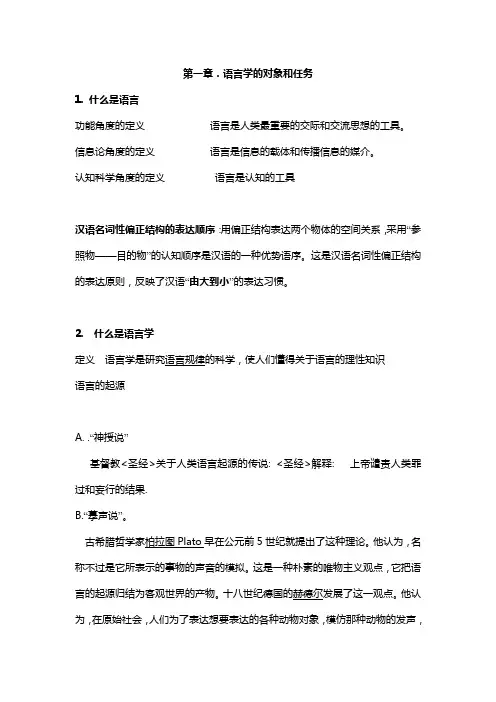
第一章.语言学的对象和任务1. 什么是语言功能角度的定义语言是人类最重要的交际和交流思想的工具。
信息论角度的定义语言是信息的载体和传播信息的媒介。
认知科学角度的定义语言是认知的工具汉语名词性偏正结构的表达顺序:用偏正结构表达两个物体的空间关系,采用“参照物——目的物”的认知顺序是汉语的一种优势语序。
这是汉语名词性偏正结构的表达原则,反映了汉语“由大到小”的表达习惯。
2. 什么是语言学定义语言学是研究语言规律的科学,使人们懂得关于语言的理性知识语言的起源A. .“神授说”基督教<圣经>关于人类语言起源的传说: <圣经>解释: 上帝谴责人类罪过和妄行的结果.B.“摹声说”。
古希腊哲学家柏拉图Plato早在公元前5世纪就提出了这种理论。
他认为,名称不过是它所表示的事物的声音的模拟。
这是一种朴素的唯物主义观点,它把语言的起源归结为客观世界的产物。
十八世纪德国的赫德尔发展了这一观点。
他认为,在原始社会,人们为了表达想要表达的各种动物对象,模仿那种动物的发声,比如拟声词。
C.“感叹说”。
古希腊哲学家伊壁鸠鲁(Epicurus, 公元前341~前270年)是其代表人物这种理论认为,原始人的感情冲动、受到惊恐后发出的喊叫等,也就是出于内心和外来的感受而发出的声音逐渐发展为感叹词,最终形成了语言。
D.“号子说”。
19世纪的法国哲学家努阿尔认为,原始人在集体劳动时会发出“咳哟”、“啊哈”等声音,以协调劳动的一致性,大致相当于今天的劳动号子,这就形成语言最初的成分——动词。
E.“劳动说”。
恩格斯首先提出来的。
恩格斯认为:一方面“劳动的发展必然促使社会成员更紧密地互相结合起来因为它使互相帮助和共同协作的场合增多了,并且使每个人都清楚地意识到这种共同协作的好处。
另一方面,劳动还使人的发音器官和大脑发达起来。
这些都是语言诞生的必要条件。
3语文学A 定义:为注解古代经典(如政治、哲学、历史、文学等经典作品),而对其中的文字\词汇\语法所作的研究.语文学是经学的附庸,没有把语言作为独立的学科研究. 又叫“前语言学”.印度宗教经典梵语:语音、语法研究西欧(希腊-罗马)古典拉丁文:语法、修辞、逻辑中国先秦典籍:汉字形音义研究三个重要的传统古印度巴尼尼<梵语语法>古希腊-罗马底奥尼修<希腊语法> 瓦罗《论拉丁语》中国“小学”中国第一部语法专著马建忠《马氏文通》(1898)采用的也是拉丁语的体系。
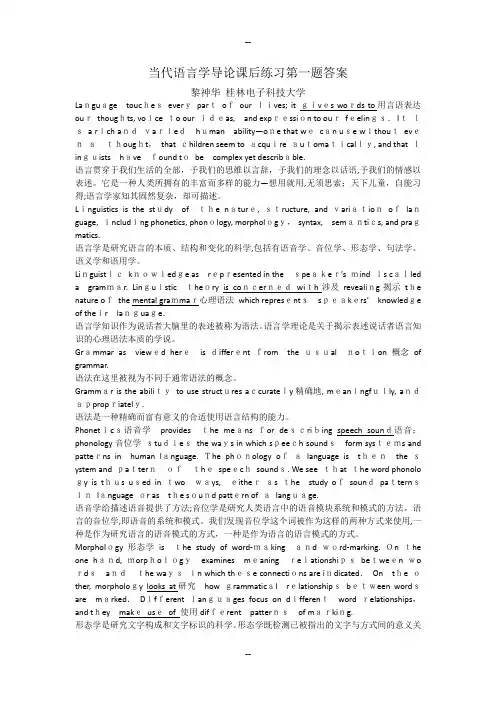
当代语言学导论课后练习第一题答案黎神华桂林电子科技大学Language toucheseverypartofour lives; it gives words to用言语表达ourthoughts, voice to our ideas,and expression to ourfeelings.Itisa rich andvariedhuman ability—one that wecan use withoutevenathought,that children seem to acquire automatically, and that linguists havefound tobe complex yet describable.语言贯穿于我们生活的全部,予我们的思维以言辞,予我们的理念以话语,予我们的情感以表述。
它是一种人类所拥有的丰富而多样的能力—想用就用,无须思索;天下儿童,自能习得;语言学家知其固然复杂,却可描述。
Linguistics is the study ofthe nature, structure, and variationoflanguage, including phonetics, phonology, morphology,syntax,semantics, and pragmatics.语言学是研究语言的本质、结构和变化的科学,包括有语音学、音位学、形态学、句法学、语义学和语用学。
Linguisticknowledge as represented in thespeaker’s mind is called a grammar. Linguistictheory is concernedwith涉及revealing揭示the nature ofthe mental grammar心理语法which representsspeakers’knowledge of their language.语言学知识作为说话者大脑里的表述被称为语法。
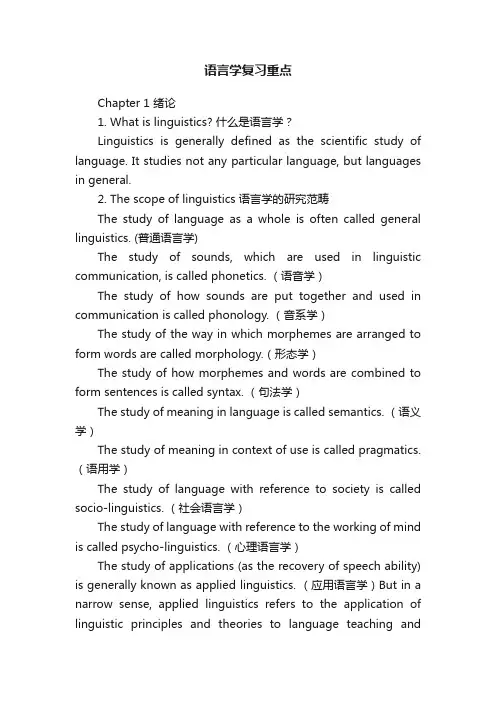
语言学复习重点Chapter 1 绪论1. What is linguistics? 什么是语言学?Linguistics is generally defined as the scientific study of language. It studies not any particular language, but languages in general.2. The scope of linguistics 语言学的研究范畴The study of language as a whole is often called general linguistics. (普通语言学)The study of sounds, which are used in linguistic communication, is called phonetics. (语音学)The study of how sounds are put together and used in communication is called phonology. (音系学)The study of the way in which morphemes are arranged to form words are called morphology.(形态学)The study of how morphemes and words are combined to form sentences is called syntax. (句法学)The study of meaning in language is called semantics. (语义学)The study of meaning in context of use is called pragmatics. (语用学)The study of language with reference to society is called socio-linguistics. (社会语言学)The study of language with reference to the working of mind is called psycho-linguistics. (心理语言学)The study of applications (as the recovery of speech ability) is generally known as applied linguistics. (应用语言学)But in a narrow sense, applied linguistics refers to the application of linguistic principles and theories to language teaching andlearning, especially the teaching of foreign and second language.Other related branches include anthropological linguistics, (人类语言学)neurological linguistics, (神经语言学)mathematical linguistics, (数字语言学)and computational linguistics. (计算机语言学)3. Some important distinctions in linguistics语言学研究中的几对基本概念Prescriptive and descriptive 规定与描写If a linguistic study describes and analyzes the language people actually use, it is said to be descriptive, if it aims to lay down rules to tell people what they should say and what they should not say, it is said to be prescriptive.Modern linguistics differs from traditional grammar. Traditional grammar is prescriptive while modern linguistics is descriptive. The task of linguists is supposed to describe the language people actually use, whether it is “correct” or not. Synchronic and diachronic 共时和历时The description of a language at some point in time is a synchronic study; the description of a language as it changes through time is a diachronic study. In modern linguistics, synchronic study is more important.Speech and writing 口头语与书面语Speech and writing are the two major media of communication. Modern linguistics regards the spoken form of language as primary, but not the written form. Reasons are: 1. Speech precedes writing; 2. There are still many languages that have only the spoken form; 3. In terms of function, the spoken language is used for a wider range of purposes than the written, and carries a larger load of communication than the written.Langue and parole 语言和言语The Swiss linguist F. de Saussure made the distinction between langue and parole early 20th century.Langue refers to the abstract linguistic system shared by all the members of a speech community, and parole refers to the realization of langue in actual use. Saussure made the distinction in order to single out one aspect of language for serious study. He believes what linguists should do is to abstract langue from parole, to discover the regularities governing the actual use of language and make them the subjects of study of linguistics.Competence and performance 语言能力和语言运用Proposed by American linguist N. Chomsky in the late 1950?s.He defines competence as the ideal user?s knowledge of the rules of his language, and performance the actual realization of this knowledge in linguistic communication. He believes the task of the linguists is to discover and specify the language rules.4.What is language? 语言的定义Language is a system of arbitrary vocal symbols used for human communication.Sapir uses “ideas” “emotions” and “desires” in his definition. Hall, like Sapir, tr eats language as a purely human institution. Chomsky?s definition is quite different, it focus on the purely structural properties of languages and to suggest that these properties can be investigated from a mathematically precise point of view.5. Design features 语言的甄别性特征Design features refer to the defining properties of human language that distinguish it from any animal system of communication. American linguist Charles Hockett specified twelve design features, five of which will be discussed here.Arbitrariness 语言的随意性Arbitrariness means that there is no logical connection between meanings and sounds. It is not entirely arbitrary. Example: different sounds are used to refer to the same object in different languages.Productivity 语言的创造性Language is productive in that it makes possible the construction and interpretation of new signals by its users. This is why they can produce and understand an infinitely large number of sentences, including sentences they have never heard before.Duality 语言的二重性The duality nature of language means that language is a system, which consists of two sets of structure, or two levels, one of sounds and the other of meaning.Displacement 语言的移位性Displacement means that language can be used to refer to things which are present or not present, real or imagined matters in the past, present, or future, or in far-away places.Cultural transmission 语言的文化传递性While human capacity for language has a genetic basis, i.e., we were born with the ability to acquire language, the details of any language are not genetically transmitted, but instead have to be taught and learned anew. This indicates that language is culturally transmitted. It is passed down from one generation to the next through teaching and learning, rather than by instinct.Chapter 2 Phonology 音系学1. The phonic medium of language 语言的声音媒介Speech and writing are the two media used by natural languages as vehicles for communication. Of the two media of language, speech is more basic than writing. Speech is prior towriting. The writing system of any language is always “invented” by its users to record speech when the need arises.For linguists, the study of sounds is of greater importance than that of writing.The limited ranges of sounds which are meaningful in human communication and are of interest to linguistic studies are the phonic medium of language (语言的声音媒介) . The individual sounds within this range are the speech sounds (语音).2.What is phonetics?什么是语音学?Phonetics is defined as the study of the phonic medium of language;It is concerned with all the sounds that occur in the world?s languages.语音学研究的对象是语言的声音媒介,即人类语言中使用的全部语音。

语言学概论(复习提纲)教学内容:(一)语言的特性:自然语言的独特性、语言的本质、语言的普遍性和多样性(二)详细介绍语言学的分支研究(语音、词汇、语义和语法) (三)语言与其他人类知识:语言与社会、语言和文字等第一讲:语言和语言学一.什么是语言?什么是语言学?(掌握)语言学:研究语言的科学二.说话和写字(理解)1.文字是作为补充有声语言而产生的,最初主要用来把言语传至远处和保留下来2.文字的基本和首要任务是补充言语的交际3.语言是第一性的,文字是第二性的三.语言能力和语言运用(了解)语言能力:what you know when you know a language语言运用:运用语言能力说出来的具体的话语语言学研究的是隐藏在话语(语言运用)背后的语言能力第二讲:语言是符号系统一.语言符号的性质和特点(掌握)★1.什么是符号(symbol)?①符号必须是可以感知的,在信息交换中不代表它自身而代表另一事物②符号与它代表的东西之间的关系是约定的2.语言符号:是声音和意义的结合体,声音是语言符号的形式(不是文字),声音和意义之间的关系是约定的3.语言符号特性:①任意性(arbitrariness):最小的语言符号的音与义的结合是任意的,由社会约定俗成②线条性(linearity):语言符号只能一个跟着一个依次出现,在时间线条上绵延,不能在空间上铺开,必须实现为一个单线性的次序才能表达信息。
二.语言符号的系统性(掌握)★1.语言系统是一个分层装置,依靠组合和替换(聚合)来运转。
语言是一个两层多级的系统,每一层都包含不同的级别两层结构形式层(语音)符号层(音义结合的符号、符号的序列)2.组合关系:在线性语流中,语言单位按顺序排列组织成更大一级的单位聚合关系:具有相同特点的同一级的单位形成一个类,这些单位之间的关系叫聚合关系3.语言系统的分支结构三.人类语言的特性(掌握)★四.动物语言(了解)第三讲:语音学一.语音和语音研究(理解)1.广义语音学:phonetics +phonology2.狭义语音学(phonetics)研究人类发音特点,特别是语音发音特点,提出各种语音描写、分类和转写方法的科学二.声波(理解)1.声音是指可听声波的特殊情形2.语音四要素★①音高:声音的高低,由频率决定②音重:声音的轻重或强弱,由振幅决定③音长:声音的长短,由振动的时间决定④音质(音色)发音体不同发音方法不同共鸣器不同3.发音要素三.音素和音标(掌握)★1.音节:在听觉上最容易分辨的音段2.音素:从音质角度划分出来的最小语音单位3.国际音标:①辅音②元音4.辅音:发辅音时气流受到阻碍①发音部位(Place of Articulation):形成阻碍的部位②发音方法(Manner of Articulation):气流受阻碍的方式5.元音:发元音时气流不受到阻碍①舌身的活动(舌位)②是否圆唇③紧松四.汉语的辅音和元音(掌握辅音表和元音图)★五.超音段特征(掌握)★第四讲:音系学一.什么是音系学(phonology)?(理解)1.一个具体语言的语音系统2.哪些语音可以分辨词义?3.哪些语音是可预测的?哪些不可预测?4.在什么语音环境下我们可以预测某些语音?二.音位和音位变体(掌握)★1.音位(phoneme):在具体语言中有区别词义作用的最小语音单位2.音位变体(allophone):在实际语流中实际呈现出来,属于同一音位的各种表层音段三.音位归纳(掌握)★1.最小对立对(minima pair):一对意义不同的词,只有一处音不同,其他语音都相同2.分布(distribution):某“音”出现的一组语音环境①对立分布:在相同的语音环境中,两个音能区别意义②互补分布:两个音不能在相同的语音环境中出现③自由变体:在相同的语音环境中,可以有多种读音3.音位归纳原则①对立的两个音必属两个不同的音位②互补的音可以归纳为一个音位③自由变体的音属同一个音位4.音位变体①条件变体:由语音环境制约的音位变体②自由变体:不同变体可以在同样的环境里无条件地变读四.音系学练习(理解)1.有没有最小对立对?2.列出每个音的出现环境(前面和后面的音)3.找出环境的自然类4.找出互补的环境5.概括每个音的出现条件6.归纳音位和音位变体(决定哪个音位变体是基本的、哪个是受限制的)五.超音段特征(掌握)★在具体语言中,具有区分词义作用的音高、音长、音重六.音位的组合和聚合(掌握)1.发音特征①区别特征:有区别音位作用的发音特征②羡余特征:被其他特征决定的发音特征,必须和其他特征共现,不具有区分音位的作用③变体特征:不具有区分音位的作用,只是音位变体具有的特征2.自然类:具有一个共同的发音特征的不同音位3.平行对称的音位聚合系统①便于记忆②聚合的成员具有相似的构成音节或者构词能力4.音节:在听觉上最容易分辨的音段①一个音节最多能有多少个组合位置?②在每个组合位置上可出现哪些聚合类?③可以出现在各个组合位置上的聚合类有没有共现的限制?5.语流音变:★语音相连时,由于受邻音的影响,或者由于说话时快慢、高低、强弱的不同,可能发生不同的变化①同化②异化③弱化④脱落⑤合音第五讲:形态学(词汇与语义)一.什么是词?(理解)1.词:具体语言中,在造句时可以自由运用的最小单位①独立运用(单说,自由与别的成分组合)②词的意义有约定性和可解释性2.语素是构词的单位,是具体语言中音义结合的最小单位①不成词语素:只能和别的语素结合成词②成词语素:本身能成为一个词, 同时也能和别的语素结合成别的词二.词和形态学(理解)1.派生和屈折2.词缀(affix):附加在另一个语素的各类构形成分①前缀(prefix):添加在词根前的词缀②后缀(suffix):添加在词根后的词缀3.词根(stem)三.语素的分类(理解)四.词的结构(掌握)★1.附加(affixation):词根+词缀2.复合(compounding):词根+词根3.重叠(reduplication)4.交替(alternation):语素内部变换5.异干交替(suppletion):用不相同的形式来填补一个词形变化表6.汉语的构词法①单纯词并列式, 偏正式复合法(词根+词根)陈述式, 支配式②合成词补充式,附加法(词根+词缀)重叠法③简称: 减缩, 紧缩, 概括五.语言的形态类型(掌握)1.分析语黏着语2.综合语屈折语多式综合语第六讲:句法学(语法学)句法研究的三方面1.句法单位、成分组构2.句法功能3.词序一.语法单位(掌握)★1.静态单位(数量有限):语素(morpheme)词(word)2.动态单位(临时的,数量无限):词组(phrase)句子(sentence)二.线性次序,层级结构和歧义(理解)1.线性次序2.层级结构3.歧义三.词组的结构(理解)四.词类(了解)1.为什么要划分词类?具体语言中,能占据不同语法位置的词是有限制的划分词类是为了更有效更方便地说明语法规则2.划分词类的依据①充当句法成分的能力(占据什么语法位置)②和别的成分的组合能力③意义④形态变化五.形态与语法范畴(掌握)★1.表达语法功能(语法关系)的手段选词词序虚词形态变化(词形变化)2.语法范畴:由词形变化表现出来的意义的聚合数时名词性动词体格态六.词组结构规则(了解)语言中片语合成句子的规则七.英语的词组结构规则(了解)八.词序类型学(掌握)VSO语言:19%SVO语言:35%VOS语言:2%SOV语言:44%第七讲:语义学一.语义学和语义研究(掌握)1.语义学(Semantics):研究语言的意义①词义②词义如何组构句义2.什么是语义?3.语义研究二.关于意义的理论(了解)1.词典释义2.心理形象(mental image)3.语义和指称(reference)4.真值条件(truth condition)5.语言使用三.传统语义研究(掌握)传统语义学(19C初):研究词义与语音、客观事物的关系,研究词义的色彩,词义的演变1.词义是词的内容, 是对客观事物现象的反映2.词的感情色彩3.词的语体色彩4.义项5.同义词;反义词;上、下位词★四.语义场和义素分析(掌握)(×)1.语义场意义相近的词W1、W2、W3……构成一个集合,称为词汇场(lexical field)/语义场(semantic field)不同的词汇场F1、F2、F3……的并集构成该语言的词汇的总和V基本观点①语言中的词在一个共同概念的支配下可以构成一个语义场②属于同一个语义场的词在意义上相互联系、相互制约、相互依存2.义素分析(语义成分分析)语言中所有实义词的意义都可以分成各种成分词的意义分解后得到的是语义特征/语义成分(semantic component)/义素(sememe)/语义原子(semantic atom)第八讲:语用学(×)一.什么是语用学?(了解)二.言语行为(理解)三.言情达意:衍推和隐涵(理解)四.会话规则(理解)五.话语分析(理解、掌握)第九讲:心理语言学(×)一.心理语言学(了解)二.语言和大脑(了解)三.语言习得的理论(了解)第十讲:语言的接触一.语言成分的借用和吸收1.借词★2.语法规则的借用二.语言的融合()三.语言接触的三种特殊表现形式()★第十一讲:语言的发展和演变思考题:1.语言符号具有任意性,是约定俗成的。
speech categories which reflect their socioeconomic, educational, occupational and ethnic background, as well as their sex and age.•语言的社会变异产生了社会方言。
社会方言又可以分为更小的语言类别。
导致语言社会变异的主要因素包括语言使用者的不同的社会地位、经济地位、学历、职业、年龄、性别等。
e) Stylistic variation 文体变异•There are differences associated with the speech situation: who is speaking to whom about under what circumstances for what purpose.•有一些差异是说话者本人的言语在不同的言语情景中所具有的差异:言语情景即在什么情况下,为了什么目的,谁与谁讲什么。
•Stylistic variation in a person’s speech, or writing, usually ranges on continuum from casual or colloquial to formal or polite according to the type of communicative situation. Style can also refer to a particular person’s use of speech or writing at all times, or to a way of speaking or writing at a particular period of time, e.g., Dickens’ style, Hemingway’s style.•根据交际情景的类型,一个人的口头语和书面语的文体会发生变化,变异区间是从随便文体或口语体到正式文体或文雅文体。
一.Antonymy (反义词):(书本P70)1.Gradable antonyms (分程度反义词):a matter of degree.eg. Old—middle-aged—young hol-warm-coldplementary antonyms (互补关系):a matter of degree between two extremes.eg. Alive― ead; male一female3.relational opposites (关系反义词):pairs of words that exhibit the reversal of a relationshipbetween the two items.eg. father-son; teacher-pupil; doctor-patient; buy-sell; above-below二、Paul Grice (保罗•格莱斯)提出的两个概念(书本P86)1.conventional implicature (规约含意,约定俗成的):is based on the conventional meaningof certain words in the language・eg. He is rich blit he is not greedy.2.particularized conversational implicature (特殊规约隐涵):is inferred by the hearer withreference to the context of communication.eg. A: Where is the steak? B: The dog looks very happy.三、Charles Hockett (霍凯特)提出的人类语言的识别特征之一(书本P8)Arbitrariness (I膛总:t生):There is no logical connection between meanings and sounds・ eg. Rumble, crash, cackle, bang四.Free morpheme (可独立存在的):a morpheme which can be a word by itself.eg. boy (书本P33)五、新构词(书本P99)1.blending (拼缀,紧缩法):a blend is a word formed by combining parts of other words,eg. Smog -一smoke+fog; motel——motor+hotel2.acronyms (首字母缩写,词首字母缩略法):are words derived from the initials of severalwordseg. IT-——information technology; CPI——consumer price index六.Language aptitude (语言能力倾向,语言学能):the natural ability for learning a second language.(书本P164)七、Semantic Changes (语意变化):(书本P102)1.semantic broadening (扩展,意思越来越广,语义扩大化)2.semantic narrowing (意思变小)3.semantic shift (转换)八.indirect speech act (间接言语行动):which aimed to explain indirect language in the light of the speech act theory.(书本P84-85)1.The primary speech act is the speaker's goal of communication while the secondaryspeech act is the means by which he achieves goal.2・ eg. A: Let's go to the movies tonight.B: I have to study for an exam. (冋答问题或者名词解释)九、Sapir-Whorf Hypotheis (假说):1. A theory put forward by the American anthropological linguists Sapir and Whorf whichstates that the way people view the world is determined wholly or partly by the structureof their native language・(书本P128)2・ Now there are mainly two different interpretations about the hypothesis: a strong version and a weak one. While the strong version believes that language patterns determinepeople's thinking and behavior, the weak one holds that former influences the latter.(全背)3・ eg. English-speaking culture tends to teach its people to name what is eful and important.4. A good illustration of this point is the word snow in Eskimo and English.十. Strategies for learning a second language?(书本P165)1.Find their own way,taking charge of their learning・anize information about language・3.Are creative,developing a "fbcT for the language by experimenting with its grammar andwords.4.Make their own opportunities for practice in using the language inside and outside theclassroo m.5・ Learn to live with uncertainly by not getting fluttered and by continuing to talk or listen without understanding every word.e mnemonics and other memory strategies to recall what had been learned・7.Make errors work for them and not against for them.e linguistic knowledge, including knowledge of their first language, in learning asecond language.e contextual cues to help them in comprehension.10.Learn to make intelligent guesses.11.Learn chunks of language as wholes and formalized routines to help them perform"beyond their competence^・12.Learn certain tricks that help to keep conversations going.13.Learn certain production strategies to fill in gaps in their own competence・14.Learn different style of speech and writing and learn to vary their language according tothe formality of the situatiori・H—> How to determine a word^s category?(书本P44)三个标准及分别的例子:1.Meaning2.infleclion3.distribution十二. Q: when ^conversation implicature occur?(书本P87)A:Only when a maxim is flouted(公然违抗).Flouting a maxin means violating blatantly ・十三、A phoneme is a phonological unit・ It is represented or realized by a certain phone in a certain phonetic context.(书本P23)十四. The description of a language at some point of time in history is a synchronic study. The description of a language as it changes through time is a diachronic study・(书本P4)十五、Krashen^ input Hypothesis (书本P163)(课本黑体字)Comprehensive input (全lif 白勺输入):i+1:i represents learners5current state of knowledge, the next stage is the i+1十六、what is morphological rules?(形态学规则)(书本P36)They are rules that govern which affix can be added to what type of stem to form a new word. 十七、what is interlanguage?(语际语,人工辅助语言,中介语)(书本P160)Proposed by S.Pit Corder and Larry Seiinker, the concept of interlanguage was established as learner's independent system of the second language, which is of neither the native language nor the second language, but a continuum or approximation from one extreme of his native language to the other of the second language・十八、What is acculturation^(语言文化移入,文化适应)(书本P135)A process of adapting to the culture and value system of the second language community. (可能考单词acculturation) intercultural communication(单词跨文化交际)十九、what is inflectional morphemes?(曲折语素;屈折词素;屈折性语素)(书本P36)Which are for the most part purely grammatical markers and signify such concepts as tense, number, case and so on.? ? ?eg. "John has noticed the change in his friend.” Here the -ed endings are morphemes which do not add any lexical meaning but represent the concept of tense and aspect.二十、what is roots?(词根)(书本P34)The root constitutes the core of the word and carries the major component of its meaning.Roots typically belong to a lexical category・二—、what is phrases?(短语)(书本P44)Syntactic units that are built around a certain word category・二十二- what is Wh Movement?(特殊疑问句)(书本P56)二十三、Sense relations between sentences (书本P71-72)(选择题一题)1.X is synonymous with Y 同义2.X is inconsistent with Y 彳:一致3.X entails Y (Y is an entailment of Y)包括4.X presupposes Y (Y is a prerequisite of X)先提条件5.X is a contradiction 矛盾6.X is semantically anomalous 反常的二十四、Pragmatics (ig用学),和语义学的最大区别?Context (书本P77-78)1.区别:What essentially distinguishes semantics and pragmatics is whether in the study ofmeaning the context of use is considered・2.总结最大区别:context二十五. Language is a system of arbitrary vocal symbols used for human communication. (书本P7)二十六、Critical Period Hypothesis (CPH)关键期假说的主要思想(书本P147)(选择)The critical period hypothesis refers to a period in one's life extending from about two to puberty. (While the strong one suggests that children must acquire their first language by puberty or they will never be able to learn from subsequent exposurethe weak holds that lang uage learni ng will be more difficult and in complete after puberty.)二十七、what is a behaviorist view of language acquisition?(语言习得的行为主义主要观点是什么?)(书本P141)Traditional behaviorists view language as a kind of behavior and believe that language learning is simply a matter of imitation and habit formation.[An innatist view of language acquisition: Chomsky proposed that human beings are bom with an innate ability known as Language Acquisition Device, or LAD. Universal Grammar (UG)An interactionist view of language acquisition]二十八、what is bilingualism?(双语能力)(书本P122)Ability to speak two languages equally well.二十九、What is Spoonerism?(斯本内现象,首音互换)(书本P186)Transposition of initial consonants in a pair of words.eg. Wrong road―long road三十、What is Garden path sentences?(径句)(书本P186)A garden path sentence is an awkward sentence that misleads the syntactic parser and takes itdown the garden path to the wrong analysis.eg. The horse raced past the barn fell.。
Aaccusative:(宾格)direct object of a verb. 动词的直接宾语affix: (词缀)Prefixes, infixes, suffixesfunction: derivational morpheme: (派生词素) –ly, un-, a-, pre-, -nessinflectional morphemes: (屈折词素)-er, -est, -ed, -ingallophone: (音位变体)alveolar ridge: (齿龈脊) The ridge just behind the upper front teeth.语言分三类:isolating language: (孤立语)=analytic language. Examples: Chinese , Vietnamese. inflecting language: (屈折语) Also fusional language. A language in which the form of a word changes to show a change in meaning or grammatical function.Latin, Greek, Arabic, French, Germanagglutinating language: (粘着语)various affixes may be added to the stem of a word to add to its meaning or to show its grammatical functionTurkish, Finnish, Japanese, Swahilianthropological linguistics:(人类语言学)aphasia:(失语症)applied linguistics: (应用语言学)argument: (论元,主目语)He gave me a ticket yesterday, He, me, and a ticket are the three argumentsaspiration: (送气音)Bbabbling: (咿呀学语)bootstrapping: (初启)To promote and develop by use of one's own initiative and work without reliance on outside help. In language acquisition, it denotes a baby’s spontaneous acquisition of the meaning and structure of adults’ simple utterances. bound morpheme:(粘着词素)Broca's area: (布罗卡区)左脑皮层控制说话能力的区域Wernicke’s area: (韦尼克区) 左脑控制语言理解的区域arcuate fasciculus 弓形纤维束连接两个区域,损害了造成aphasia失语症。
英语语言学导论复习提纲IV. Directions: Explain the following terms, using one or two examples for illustration.1.affix p372.affricate3.applied linguistics4.articulatory phonetics5.aspiration6.back-formation7.blending8.bound morpheme9.broad transcriptionplementary distributionponential analysis12.context13.Conversational implicature14.deep structure15.duality16.free morpheme17.homonymy18.idiolect19.illocutionary act20.indirect speech act21.inflection22.linguistic sexism23.morpheme24.Move α25.narrow transcription26.perlocutionary act27.phatic communion28.phoneme29.phonology30.pidgin31.predication32.presupposition33.register34.relational opposites35.speech community36.supresegmental features37.tone38.trace39.utterance40.voicelessVI. Answer the following questions.1.According to Austin, what are the three acts a person is possibly performing while making anutterancement with at least three examples on the following statement:”There is undoubtedly nosingle cause of language change.”3.Do you think that the pictographic characters in Chinese such as 人、日、火contradict withone of the design features of language —— arbitrariness? Why or why not?4.Explain what is sense and what is reference with examples5.Explain with examples the three notions of phone, phoneme and allophone, and also how theyare related6.For what reasons does modern linguistics give priority to speech rather than to writing?7.How do phonetics and phonology differ in their focus of study?8.How is language related to society?9.How is Saussure`s distinction between langue and parole similar to Chomsky`s distinctionbetween competence and performance?10.How is utterance meaning different from sentence meaning?11.What are derivational affixes and inflectional affixes? Give examples to show their differentfunctions.12.What are the four major views concerning the study of meaning?13.What are the four maxims of the CP? Try to give your examples to show how flouting thesemaxims gives rise to particularized conversational implicatue.14.What are the major branches of linguistics? What does each of them study?15.What are the three branches of phonetics? How do they contribute to the study of speechsounds?16.What contribution did Saussure make to modern linguistics?17.What is blending, abbreviation and back formation?18.What is entailment and what is presupposition? Give examples to illustrate19.What is the difference between competence and performance, according to Noam Chomsky?20.What is the difference between Sense and Reference in semantic study? Explain withexamples21.What is the difference between sentence meaning and utterance meaning?22.What makes modern linguistics different from traditional grammar?23.Why is language defined as a system of arbitrary vocal symbols used for humancommunication?24.Why is syntax regarded as a system of rules?25.Why is the word order in Modern English more rigid than that in Old English?。
Introduction to Contemporary LinguisticsChapter1Human superiority lies in his unique endowment-----the ability to talk, or rather, to communicate by means of language.Talmud: god created the world by a word, instantaneously, without toil or pains.Widdowson: the primacy of language in the way human beings conceive of the world.Language is a vehicle of power, for control, for creation, and for change.The study of human language is called linguistics.Linguistics deals with human language as a whole or as particular languages.1.As a whole: the system of human communication which consists of the structuredarrangement of sounds (or their written representation) into larger units,e.g.morphemes, words, sentences, utterances.2.As particular language: like French language, they are particular systems ofhuman communication used by people living in different parts of the world.There is a continuum from one language to another.Varieties of language: Any particular language is in essence a set of varieties.1.local varieties区域变体–dialects and accents(the former differ from each otherin pronunciation, vocabulary, and even grammar; the latter only in pronunciation ) 2.social varieties—sociolects社会方言(=social dialects , used by people of differentclasses, ages, or sexes ),3.historical varieties—temporal variety.(e.g. the 17th century English)4.stylistic or occupational varieties---registers语域(e.g. formal English, scientificEnglish)5.individual varieties—idiolects个人语言.ually a language has an officially declared or generally considered standarddialect(e.g. Putonghua in China, General American in the US)From Prescriptivism to DescriptivismPrescriptivism is the view that one variety of language has an inherently higher value than others.(try to impose rules from some high prestige language to some lower prestige language, like Latin and English)Descriptivism is the policy of describing languages as they are bound to exist.Usages of different varieties should be observed and recorded instead of being judged with some imposed norms.Endowed or conventional?Plato’s problem: How can every human being develop a rich system of linguistic knowledge on the basis of limited and fragmentary empirical evidence?Side of endowment: nativists(天生论) or mentalists(心智说)Plato:1.Man’s knowledge came from universal truths.2.There was a universally correct and acceptable logic of language for man tofollow in expressing his ideas.3.Knowledge of language was not learned but recalled.Chomsky:There is a biological, physiological entity inside our brain which decides what we speak.Chomsky has given a name to this entity----UG, or universal grammar. His epistemology of the knowledge of language foes as follows:1.Every human being has the language competence能力, because he has the inbornUG which other species lack.2.UG is the initial state of the human language faculty语言器官/机制which alonecannot enable a human baby to speak. A baby needs to be exposed to the linguistic environment of a certain language and accumulate experience.3.Due to the effect of later experience, the baby’s mind develops from the initialstate into the steady state, which corresponds to the competence of speaking a specific human language.Side of convention: behaviorist or empiricistsAristotle: knowledge of language was arrived at by convention and agreement of the speakers of a given language.Xun zi: a name was accepted through public agreement, and the appropriateness of naming a thing lay in convention.The power of language exists in its countless varieties, not relying on any universal standard.ConnectionismDiachronic(历经时间的): focus on the comparison between languages and the exploration of the historical change and variation of some ancient languages./ of, relating to, or dealing with phenomena (as of language or culture) as they occur or change over a period of timeSynchronic(共时的): research of the facts of language agreed upon or shared by his members of language community at a given point in time./ concerned with events existing in a limited time period and ignoring historical antecedents GlossaryEndowments: (天赋) the natural quality that a person is made rich of from the birth.Register: (语域) the words, style, and grammar used by speakers and writers in particular conditions, namely a socially defined variety of language.Idiolect: (个人语言) the linguistic system of an individual speaker.Sociolect: (社会方言) also social dialect. Variety of a language defined by social factors such as age, religion, ethnicity, or socioeconomic status. Sociolects maybe classed as high or low (in status).Prescriptivism :(规定主义) the imposition of arbitrary norms upon a language, often in defiance of normal usage.Descriptivism :(描写主义)the policy of describing languages as they are bound to exist.Nativism: (天生论) philosophical and psychological position which holds that cognitive development of humans arises from “innate ideas”. The nativist position has been used to explain how children are able to learn language and contrasts with the belief that all human knowledge comes from experience (empiricism).Mentalism: (心智说)psychological and philosophical concept picked up and developed by Chomsky(1965), which attempts to describe the internal (innate) language mechanism that provides the basis for the creative aspect of language development and use.Dualism: (二元论)a philosophical system that recognizes two ultimate and independent principles in the scheme of things, such as mind and matter.Monism: (一元论) a general name for those philosophical theories which deny the duality of matter and mind.Universal Grammar (UG): (普通语法)the genetically endowed information consisting of principles and parameters that enable the child to deduce a grammar from the primary linguistic data.Language competence: (语言能力) knowledge of language; the linguistic capacity of a fluent speaker of a language.Parameter: (参数) a dimension of grammatical variation between different languages or different varieties of the same language.Empiricism: (经验论) philosophical and psychological position which holds that the psychological development of humans arise primarily from experience and learning.Connectionism: (连通主义) a theory of cognition which draws inspiration from the way the billions of neurons in the brain are interconnected in complex ways to produce a network of associations. It holds that the complexity of language emerges from associative learning processes being exposed to a massive and complex environment.Chapter2Speculations: origin of languagePlato----legislatorHerder----godUniversal harmony is embraced as the foundation of modern linguistics as a science. Galilean thesis----nature is perfectObservationResearchEvery person’s lexical knowledge of his first language is tacit and natural, with a tendency to influence, often unknowingly, his second language learning. Thisinfluence is called transfer.Three adequacies:1.Observational adequacy2.Descriptive adequacy3.Explanatory adequacy (providing a descriptively adequate grammar for everynatural language, and does so in terms of maximally constrained set of universal principles which represent psychologically plausible natural principles of mental computation.)TestingA theory in science must not be pure speculation but testable at observational, descriptive, and explanatory levels.Science tells us that nature is a physical continuum连续体, which does not break itself into physics, chemistry, psychology, linguistics…; these disciplines学科are not facts but our decisions.GlossaryL1: (第一语言) a person’s first languageL2: (第二语言) a person’s second language. To be more specific, one could refer to a person’s L3, L4, and so on. However, the general term L2 is frequently used to refer to any language learning or used after the first language has been learned.Fossilization: (僵化) incomplete L2 acquisition featured by the fact that progress in a certain aspect of the target language stops and the learner’s language becomes fixed at an intermediate state. It can take a number of forms, such as fossilized accent or syntax. Fossilization can be a permanent feature of the learner’s language.Chapter3 phoneticsPhonetics: the science of speech sounds. It aims to provide the set of features or properties that can be used to describe and distinguish all the sounds used in human language.In accordance with the three phases just mentioned, phonetics is divided into three sub-fields.1.Articulatory phonetics发音语音学studies speech production by the speechorgans;2.Acoustic phonetics声学语音学studies physical properties of speech sounds, theway sounds travel from the speaker to the hearer;3.Auditory phonetics听觉语音学studies the perception of speech sounds in thehuman auditory and cognitive system.IPA: International Phonetic AlphabetThe design principles of IPA were that there should be a separate letter for each distinctive sound, and that the same symbol should be used for that sound in any language in which it appears.A “sound” people say they produce is actually a combination of sounds called asyllable, which is often related to a chest pulse.(syllable>=sound)The properties of these separate sounds, or segments in phonetician’s jargon, can be described in several dimensions, the place of articulation and the manner of articulation.1.The place of articulation refers to the point in the vocal tract at which the mainclosure or narrowing is made so as to modify the flow of air from the chest to the mouth in producing a sound.2.The manner of articulation refers to the type of constriction收缩or movementthat occurs at any place of articulation.ArticulationThe production of different speech sounds through the use of these organs is known as articulation.Speech organs:the vocal cords(声带)the lungsthe windpipe(trachea)the pharynx(咽)the nosethe mouthA main source of vibration is provided by the vocal cords. The vibration of the vocal cords also gives us pitch.ConsonantsConsonants are sounds made by a closure in the vocal tract, or by a narrowing from which air cannot escape without producing audible friction.摩擦Two reference points are involved in defining consonantal places of articulation. One is the active articulator which moves; the other is the passive articulator with which the active one makes contact.Classified according to the places of articulation:eleven possible places of articulation for consonants1.Bilabial双唇音, formed by bringing the lips together , e. g. [ p ] , [ m] . Here thefunction of lips is somewhat complicated: they both can be regarded as the active and passive articulators simultaneously.bio-dental唇齿音, formed by the lower lip against the upper teeth, e . g. [ f] .3.Dental齿音, formed by placing the tip of the tongue against the upper teeth, e . g.[ð].4.Alveolar齿龈音, formed by placing the tip or blade of the tongue against thealveolar ridge, e. g. [ t ] .5.Palatal腭音, formed by the front of the tongue against the hard palate, namely,the roof of the mouth, e . g. [ j] .6.Palato- alveolar腭龈音, formed midway between the places of articulation forpalatals and alveolars: the blade ( and sometimes the tip) of the tongue articulates with the alveolar ridge, with a simultaneous raising of the front of the tongue towards the hard palate , e. g. [ʃ] .7.Velar软腭音, formed by the back of the tongue against the soft palate, e. g. [ k] .8.Glottal声门音, formed by the vocal cords coming together to cause a closure orfriction, e .g. [ h] .9.Retrofle卷舌音, formed when the apex of the tongue is curled back in thedirection of the hard palate, as heard in many Indian English accents.10.Uvular小舌音, formed by the back of the tongue against the uvula, as heard insome accents of French.11.Pharyngeal咽音, formed in the pharynx, the part of the throat above the larynx.Specifically, the front wall of t he pharynx articulates with the back wall, as heard in Arabic .Classified according to the manner of articulation1.The first factor is the degree of the constriction of airflow(气流的阻塞). At leastsix main classes can be distinguished in English.1)Plosive爆破音, formed by completely closing the air passage and suddenlyremoving the obstacle , so that the air escapes making an explosive sound, e. g.[ p] ,[ d] . It belongs to a broader category called“stop”which includes closures produced by air streams not from the lungs, as encountered in some southern African languages.2)Nasal鼻音, formed with the soft palate lowered, thus allowing air to resonate inthe nose, e . g. [ m] .3)Affricate塞擦音, a consonant which starts as a plosive, but instead of endingwith plosion, ends with a fricative made in the same place, e. g. [tʃ] .4)Liquid流音, formed by some obstruction of the air stream in the mouth, whichseems not enough to cause any real constrict ion or friction, e. g. [ l] , [ r ]. [ l] is called a lateral liquid, because in making it, an obstacle is placed in the middle of the mouth, leaving the air free to escape at one or both sides.5)Fricative擦音, formed by a narrowing of the air passage at some point so thatthe air in escaping makes audible frication. e. g. [ f] , [ z] . Some fricatives are also called sibilants齿擦音, which are made with a groove- like structure in the front part of the tongue, producing a kind of hissing sound, e. g. [ s] , [ʃ] .6)Glide滑音, sometimes called semi -vowel because it is typically produced withthe tongue moving, or“gliding, to or from the position of a nearby vowel, e.g.[ h] , [ w] .2.The second factor is voicing(浊音). V oice is caused by the vibration of the vocalcords.3.The third factor is aspiration(送气音). This is the sound of air rushing through thevocal tract, usually found after the release of plosive consonants in some situation.V owelsV owels are sounds in which there is no obstruction to the flow of air as it passes from the larynx to the lips.Different vowels result from changing the shape of the mouth; all of them are voiced continuous sounds.The qualities of vowels depend upon the positions of the tongue and lips.[i:] close vowels , [a:] open vowels, [e] semi-closed vowels, [ɔ:] semi-open vowelsV owel quality is also largely dependent on the shape of the lips.Four rounded vowels: [u:] [u][ɔ:][ɔ], they are all back vowels.[a:]is the only English back vowel that occurs without lip rounding.There is another interesting rule: all the long vowels( e.g. [i:] [u:])are tense vowels紧元音, and all the short vowels ([i] [u]) are lax vowels松元音.Every vowel constitutes a single syllable. The vowel can be a monophthong, a diphthong, or even a triphthong that contains three distinctive qualities, e.g.[ai ə]. However, not every syllable contains a vowel. The second syllable of the word little[litl] has no vowel after the plosive [t] but a liquid [l].PhonemesPhonemes have no meaning of themselves, but they are the smallest linguistic unit, whose change will lead to the change of meaning. A phoneme is defined as the smallest unit of sound in a language which can distinguish two words. (//) AllophoneAllophone is the phonetic variant of a phoneme, which can be substituted of another without bring about a change of meaning. ([])Complementary distribution and free variationA phonetic property特性,特质that distinguishes phonemes from one another is called a distinctive feature.Phonology and phoneticsPhonetics is more specifically the study of how speech sounds are produced, what their physical properties are, and how they are interpreted. (how)Phonology is a description of the sounds of a particular language and the rules governing the distribution of those sounds. Furthermore, phonology is also concerned with the universal properties of natural language sound systems and aims at revealing the general principles of the sound patterns of all languages. (what)Stress and pitchPitch is the auditory sensation of the height of a sound.There are two ways in which languages make use of pitch variations in speech.1.In languages such as English, French, and German, regular sequences of differentpitches characterize stretches of speech between pauses and are known collectively as intonation. The differences of intonation may correlate with different types of utterances.2.In languages such as Chinese , Vietnamese, Thai, and Zulu, pitch differences helpto distinguish one word from another and may be the only differentiating feature between two or more words whose composition is the same in terms of consonants and vowels. Pitch differences used in these ways are called tones and these languages are called tone languages.Stress, pitch, tone and intonation are also called suprasegmentals超切分音位because they relate to aspects of pronunciation that go beyond the production of individual segments.GlossaryPhonetics: (语音学) the study of speech sounds; how they are produced in the vocal tract (articulatory phonetics发音语音学),their physical properties (acoustic phonetics声学语音学),and how they are perceived (auditory phonetics 听觉语音学).Phonology: (音系学) the study of the sound system of a language; how the particular sounds contrast in each language to form an integrated system for encoding information and how such systems differ from one language to another.V ocal folds: (声带) also vocal cords/lips/bands. Two muscular folds in the larynx(喉) that vibrate as a source of sounds.V ocal tract: (声道) the connected passages inside the head which form the system used to produce speech. It starts at the larynx and includes the pharynx, the mouth and the nasal cavity.Glottis: (声门) the aperture between the vocal folds.Larynx: (喉头) the part of the trachea containing the vocal folds.Palate: (硬腭) also known as the “hard palate”or the “roof of the mouth”; the upper surface of the mouth where there is bone beneath the skin.Soft palate: (软腭) also velum. The flap of soft tissue which forms the continuation of the palate at the back of the mouth, and may be lowered to permit nasalization.Trachea: (气管) the “windpipe”passes up from the lungs to the vocal tract beginning with the larynx.Uvula: (小舌) the small lobe hanging from the bottom of the soft palate.Aspiration: (送气音) a puff of air that follows the release of a consonant when there is a delay in the onset of voicing. It is symbolized by a superscript h (e.g. , [p h])Phoneme: (音素,音位) the smallest unit of sound in a language which can distinguish two words.Minimal pair: (最小语对) two words in a language that differ only by a single distinctive sound (one phoneme) in the same position and have different meanings, e.g., pin and bin.Allophone: (音位变体) one of a set of nondistinctive realizations of the same phoneme. ([])Complementary distribution: (互补分布) the occurrence of sounds in language such that they are never found in the same phonetic environment. Sounds that are in complementary distribution are allophones of the same phoneme.Free variation: (自由变异) term used to refer to two sounds that occur in overlapping environments but cause no distinction in the meaning of their respective words.Distinctive feature: (区别性特征) a particular characteristic which distinguishes one distinctive sound unit of a language from another or one group of sounds from another group. For example, in the English sound system, one distinctive feature which distinguishes the /p/ in pin from the /b/ in bin is VOICE.Stress: (重音) the increased duration and loudness of a syllable compared to othersyllables in the same word.Pitch: (音高) the auditory sensation of the height of a sound.Tone: (声调) the distinctive pitch level of a syllable.Suprasegmental: (超切分音位) a vocal effect extending over more than one segment, e.g. , tone, length, and stress.International Phonetic Alphabet(IPA): (国际音标) a system of symbols for representing the pronunciation of words in any language according to the principles of the international phonetic association.Chapter4 morphologyWords are not the smallest unit of meaning. They are composed of smaller units of meaning, called morphemes. Morphemes are the minimal language units.Morphology deals with word structure.1.Free morphemes—morphemes that can stand alone as a word.1)Many words are themselves morphemes, such as big and book. They cannot bebroken into smaller units that in themselves carry meaning.2)Many other words are created by joining together two morphemes, e.g.blackboard,in which the two morphemes black and board can be recognized as meaningful words by themselves.2.Bound morpheme, which occurs only when attached to another morpheme, suchas -ly in happily and un-in unhappy.Such bound morphemes are called affixes, including the prefixes and the suffixes. The function of an affix can be derivational派生的,衍生的or inflectional屈折的.1) A derivational morpheme is one that is added to a root to form a new word thatdiffers, usually, in its part-of-speech词性classification. For example, when the suffix-ness is added to the adjective happy, the noun happiness is formed.Prefixes as derivational morphemes usually change the basic meaning of a word but do not change its part- of-speech classification .(即系本来系动词就系动词)2)Infix3)An inflectional morpheme indicates certain grammatical properties associatedwith nouns and verbs, such as gender, number, case, and tense. Unlike highly inflected languages such as Latin, English has very few inflectional morphemes.In English, the inflectional morphemes are all suffixes. The suffix -s, which indicates plurality in nouns as well as the third-person singular in verbs, is an inflectional morpheme; the past tense suffix-ed, which is added to verbs, is another.According to Wilhelm von Humboldt, languages of the world can be classified morphologically into three types: isolating, inflecting, and agglutinating.1.An isolating language is also called an analytic language or root language, inwhich all the words are invariable. Chinese, Vietnamese and Samoan are typical cases.2.An inflecting language is also called a synthetic language or fusional language, inwhich grammatical relationships are expressed by changing the internal structure of the words—typically by the use of inflectional endings which express severalgrammatical meanings at once. Latin, Greek, and Arabic are clear cases.3.An agglutinating language is also called agglutinative language, in which a wordtypically consists of a neat linear sequence of morphemes, all clearlyrecognizable. Turkish, Finnish, Japanese, and Swahiliare usual cases.Morphemes in ChineseChinese is regarded as a typical analytical language and also has some inflectional and agglutinating structures.Most of Chinese free morphemes are monosyllabic because Chinese is a tone language.CompoundCompounding is a process that forms new words not by means of affixes but from two or more independent words. Compounds are different from phrases in that they symbolize an integrated整体的concept.There are different semantic relationships within the morphemes comprising a compound.Idiomatic powerIdiomatic 惯用的,成语的expressions: metaphoric(e.g. I'm really tied up无法分身.),allusive(e.g. the ruling party met its Waterloo 毁灭性的打击in the new election.), a majority are institutionalized.GlossaryMorpheme: (词素) smallest linguistic unit that can have a meaning or grammatical function.Morphology: (形态学) the study of word-making and word-marking. On the one hand, morphology examines meaning relationships between words and the ways in which these connections are indicated. On the other, morphology looks at how grammatical relationships between words are marked. (G. Tserdanelis& W. Wong: Language files)Also the study of the internal structure of words, and of the rules by which words are formed, is called morphology. (V. Fromkin&R. Roman: An Introduction to Language)Free morphemes: (自由词素) morphemes that can stand alone as a word.Bound morphemes: (粘着词素) morpheme that always attaches to other morphemes, never existing as a word itself.Affix: (词缀) a bound morpheme that changes the meaning or syntactic function of the words to which it attaches. Prefixes, infixes and suffixes are the three types of affixes.Prefix: (前缀) an affix that attaches to the beginning of a stem.Suffix: (后缀) an affix that attaches to the end of a stemInfix: (中缀) a type of bound morpheme that is inserted in to the root.Derivational morpheme: (派生词素) morphemes that change the meaning or lexical category of the words to which they attach.Inflectional morphemes: (屈折词素) morphemes that serve a purely grammatical function, never creating a new word but only a different form of same word.Isolating language: (孤立语) also analytic language. A type of language in which words consist mainly of one morpheme and sentences are composed of sequences of these free morphemes. Grammatical relationships are often indicated by word order. Examples are Chinese and Vietnamese.Inflecting language: (屈折语) also fusional language. A language in which the form of a word changes to show a change in meaning or grammatical function.Agglutinating language: (粘着语) a language in which various affixes may be added to the stem of a word to add to its meaning or to show its grammatical function.Compound: (复合词) a word that is formed by combining two or more words.Idioms: (习语) an expression which functions as a single unit and whose meaning cannot be worked out from its separate parts.Collocation: (搭配) the way in which words are used together regularly.Stem: (词干) the part of a word that serves as a base for forming new words by the addition of affixes. For example, work is the stem of worker; worker is the stem of workers.Tone language: (声调语言) a language in which word meanings or grammatical contrasts are conveyed by variations in tone.Synthetic languages: (综合语) language in which affixes are attached to other morphemes, so that a word may be made up of several meaningful elements including inflecting languages and agglutinating languages.Chapter5 syntaxSyntactic tree of a sentence reveals that the relationship between the phrases of a sentence is not linear but hierarchical.Family tree sequence次序is top-down; syntactic tree sequence is bottom-up. The bottom-up process in sentence production is called merging合并.S=NP+VP(V+NP)The two words of the VP play different roles----head and complement. A head of a phrase is the key word which determines the properties of the phrase.The I (inflectional morpheme) plays an essential role in merging an NP and a VP into a sentence.S→IP=NP+VP(V+NP)Two groups of syntactical categories:lexical categories and functional categories.1.Lexical categories: all the content words, namely nouns, verbs, adjectives, andadverbs2.Functional category: any word or morpheme which has no descriptive contentand which serves an essentially grammatical function belongs to a. A functional category plays a role like glue in combining content words into phrases and phrases into a sentence.XP can be defined as the maximal projection headed by X, and X itself, i. e. the head, as the minimal projection.I is a functional category devised by Chomsky whose members include not onlyinflectional morphemes but also finite auxiliaries限定助动词(which are inflected for tense/agreement ) , and the infinitival particle to.CP refers to complementizer phrase and can be found in analysis of complex sentence as well as wh-questions and topicalization.When a constituent is made the topic of a sentence, it may be moved into a more prominent position at the front of the sentence. This process is called topicalization.话题化Topicalization does not involve a dummy movement, unless the topicalized constituent is negative.GlossarySyntax: (句法学) syntax is the subfield of linguistics that studies the internal structure of sentences and the relationship among their component parts.Content word: (实词) words which refer to a thing, quality, state, or action and which have meaning when the words are used alone. Content words are mainly nouns, verbs, adjectives, and adverbs.Sentence: (句子) the largest linguistic unit which is held together by rigid grammatical rules.Specifier: (指示语) the grammatical function fulfilled by certain types of constituent which (in English ) precede the head of their containing phrase.Complement: (补语) in X-bar theory, a syntactic unit that is defined as the sister to the head of a phrase.X-bar theory: (X-阶标理论) an approach to syntax which attempts to show the general principles of language rather than deal with the structures of one particular language. “X” is a variable denoting any word category concerned.Projection: (投射) a constituent which is an expansion of a head word. For example, a noun phrase such as students of linguistics is a projection of its head noun students.Topicalization: (话题化) A device which marks sth as a topic by simply moving the topic to the front of the sentence, as in This book I can’t recommend. Chapter6 semanticsPropositionAn information receiver usually focuses his attention on the meaning of a sentence rather than the form.When we put a sentence in our mind by reading or listening, our mind will immediately treat it as a set of meaning units, called propositions.The core of a proposition is a verb.1.An intransitive verb----1 NP-the subject(external argument);2.An simple transitive verb----2 NPs-subject(external argument) and object(internalargument);3.An ditransitive verb 双宾语动词----3 NPs-subject(external argument), directobject and indirect object(internal argument);4.An unusual verb in English, rain, requires no NPs.。